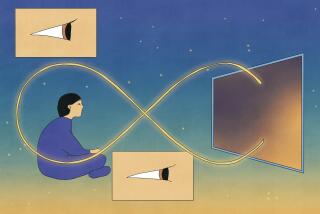Plumbing the Shallows of Television : TELEVISION<i> by Michael Winship; introduction by Edwin Newman (Random House: $19.95; 358 pp., illustrated) </i>
- Share via
Television was first theorized in the 19th Century, and working models were demonstrated as early as the 1920s. It was in 1948, however, that a breakthrough occured that opened the way for the modern broadcasting industry. RCA Corp., which operated the largest radio network at the time, took over New York’s Madison Square Garden to demonstrate a new kind of television camera that required only a small amount of light to produce high quality video images.
“Where before we had needed (an) abnormal and harmful amount of light, all of a sudden, with one foot-candle, we could light a scene, we could get a mood, we could create a character,” recalls Worthington Minor, who was manager of program development for CBS at the time, in a new large format book called simply “Television.”
At that moment, writes author Michael Winship, Miner said he realized that “‘television couldn’t miss. It was going to be able to take dramatic programs into the home . . . All of a sudden, we had an instrument that reproduced a quality picture with the atmosphere and mood that Hitchcock or Bergman might require.”’
Television has since only rarely scaled the heights of a Hitchcock or Bergman, but it has produced many memorable moments, a sprinkling of which are reported in “Television” through the eyes of actual participants. It is these first-hand accounts that represent the book “Television” at its best. These pioneers and producers, actors and programmers, newsmen and technicians are able to place the reader at the moment of creation. They can help us understand how the role of TV grew in our life, particularly as it became a startling window on news events such as the Kennedy assassination, the Vietnam War, the space program and a variety of live sporting events.
It is exciting and entertaining, but like television itself an ultimately shallow approach to the presentation of history. Sections such as The Golden Age, Sitcoms, Dramas, The News and The Business provide a briskly paced survey from the earliest days through the present, but the scholarship isn’t thorough. You get the feeling, to borrow a paraphrase from “Rolling Stone” magazine, this is all the news that fits.
Still “Television” makes for an entertaining jog through a popular medium, reflecting the origin of the book itself. “Television,” crammed with still photographs from classic TV shows, is described by its author as companion to an eight-part public television series with the same one word name. It all began with a history of TV done by Granada Television of Great Britain. When U.S. rights were picked up by the Public Broadcasting Service, they wanted to add new material to reflect the American role in bringing the tube to life. To make it visual, the history was presented in a series of interviews. What we end up with in the book are long transcribed quotes from the eyewitnesses to broadcast history, interspiced with generally brief bridges of exposition by the author, a self-described “television junkie” who was also co-producer of the American TV series. Historians, who are less often also fans, have had trouble in the past taking television seriously as a subject for study, but Winship obviously has no such qualms.
His mission in “Television” is not to question the value of the medium in relation to the rest of society, but rather to put a spotlight on the historic moments, primary movers and sacred institutions (mainly the three networks) which contributed to its development.
Winship isn’t afraid to provide a forum for criticism of television. If anything a surprising amount of self-abuse pours out from people who have become very wealthy thanks to the medium. There are also those sincerely perplexed by the inherent weaknesses of the system. Journalist Bill Moyers decries TV’s “willingness to fall back on the picture alone.” He says that is “at the heart of the malaise that afflicts commercial television. A picture by itself explains nothing. Journalism means going back, looking at that picture and finding out what it means.”
Unfortunately most TV news, like this book, seems to prefer piling up images rather than fiting them into the puzzle of modern society. That is why “Television,” which goes down as easily as a helping of fast food, is a book that will be most enjoyed by those whose own development is measured by the passing of classic TV series. They are less likely to be troubled by questions about the impact on the average citizen of sitting in front of a glowing box for six or seven hours each and every day. They will agree with the concluding statement of “Television” by science-fiction author Arthur C. Clarke: “You cannot have a modern society without television. It is as simple as that.”
More to Read
The complete guide to home viewing
Get Screen Gab for everything about the TV shows and streaming movies everyone’s talking about.
You may occasionally receive promotional content from the Los Angeles Times.






